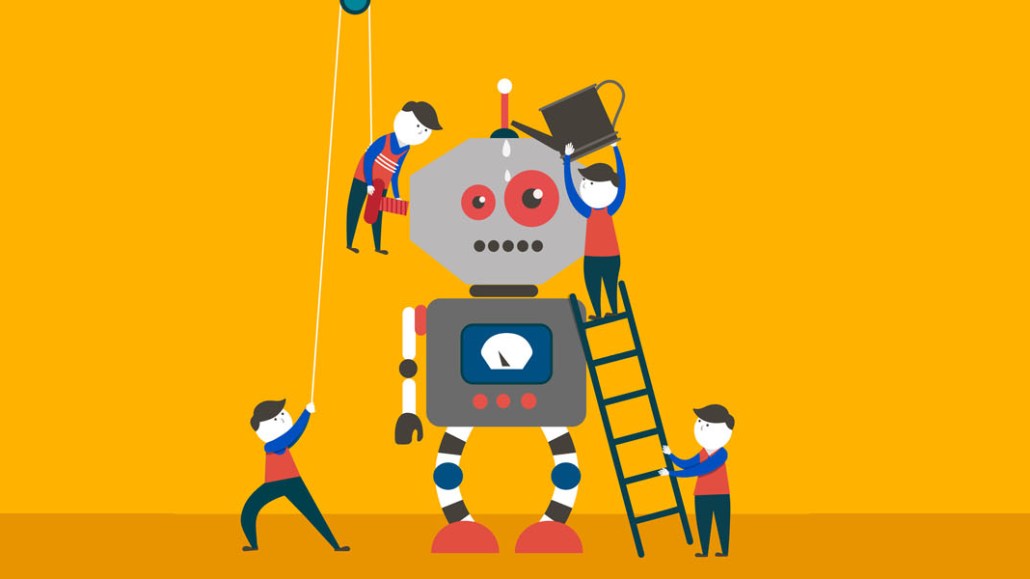Save 50% on a 3-month Digiday+ membership. Ends Dec 5.
How Dotdash Meredith worked through the challenge of integrating two major publishers’ tech stacks

This article is part of Digiday’s coverage of its Digiday Publishing Summit. More from the series →
Marriages aren’t easy. Neither are mergers. Neither are integrating the product infrastructures undergirding the combining companies. Just ask Dotdash Meredith chief product officer Adam McClean.
“The longest year and four months of my life, for sure, and not the easiest either,” McClean said on stage at the Digiday Publishing Summit on March 27 in Vail, Colorado.
Unifying the product stacks of two large publishers does not present as an easy undertaking. And however hard McClean and his team had expected it to be, it was harder. And it took longer. After the Dotdash Meredith merger closed in December 2021, the company expected the product integration to be completed by summer 2022. It’s still in the works. The delay ended up contributing to Dotdash Meredith’s year-over-year digital revenue decline in the third quarter.
“The scale and complexity was certainly unlike anything we had ever experienced before,” said McClean. “And so even though we had our best playbook and best estimations in place, we just couldn’t move fast enough.”
One reason for the delay was the scope of the work. When the company previously had to move acquired publications onto its tech stack, it usually only had to concern itself with one publication at a time, and these publications were relatively younger publications without legacy product baggage. Meredith, by contrast, was the home to publications on the other end of the spectrum, publications like People and Entertainment Weekly that cannot just go dark to ease the integration process. In all, the company needed to unify the ad tech powering more than 40 publications.
“We could just turn things off like Brides, Byrdie, Investopedia. You could stop sending emails for a week if the system wasn’t ready; it wasn’t going to break the brand,” said McClean. “People goes live all the time. Entertainment Weekly goes live — like, you can’t just stop the process.”
Another complicating factor was reconciling the publications’ integrations with Google’s publisher ad server, Google Ad Manager. Even though both Dotdash and Meredith used GAM, each side “had unique account strategy management systems. Both had inventory management. Both had targeting systems. And figuring out exactly how to stitch that together was the most complicated,” McClean said.
Ad position: web_incontent_pos1
Eventually, though, the 500-plus-person product development team from the two companies was able to sort out the ins and outs of Meredith’s properties. By October, 95% of the traffic to Meredith’s properties was running through Dotdash’s publishing and ad tech stack.
“We moved over a million pieces of content, migrated or killed about a hundred or two hundred thousand pieces of content in cleanup and then retrained hundreds and hundreds of editors on new CMS systems. It was a very busy year,” he said.
And the work isn’t over. Just last week Dotdash Meredith completed the migration of Eating Well, a food publication that exemplifies the edge cases of what Dotdash Meredith’s product teams have had to deal with.
“They have really complicated advanced nutrition [content] that most nutrition providers for our recipes wouldn’t even offer. So we had to figure out how to build that whole new capability into the platform, whereas most of the other food brands were pretty standard,” said McClean.
Asked when he expects Dotdash Meredith to be 100% complete with the integration, McClean said, “I’m optimistically thinking we’re going to be done in Q2.”
Ad position: web_incontent_pos2
By then, Dotdash Meredith’s product team may have another technology to integrate into its tech stack: ChatGPT. The company has been outspoken about not using OpenAI’s generative AI tool to produce content, but it is looking at opportunities for ChatGPT to aid its editorial teams responsible for content creation, such as by helping to identify topics for potential coverage.
Asked if that meant integrating ChatGPT into Dotdash Meredith’s content management system, McClean said, “Into the CMS, into helping us figure out where there are content opportunities. But then you have to put your actual human head on and be like, ‘Should the brand write about that even though that is a hole in the market?’ It can help boil that ocean of the internet for us in some really interesting ways.”
More in Media

What publishers are wishing for this holiday season: End AI scraping and determine AI-powered audience value
Publishers want a fair, structured, regulated AI environment and they also want to define what the next decade of audience metrics looks like.

Digiday+ Research Subscription Index 2025: Subscription strategies from Bloomberg, The New York Times, Vox and others
Digiday’s third annual Subscription Index examines and measures publishers’ subscription strategies to identify common approaches and key tactics among Bloomberg, The New York Times, Vox and others.

From lawsuits to lobbying: How publishers are fighting AI
We may be closing out 2025, but publishers aren’t retreating from the battle of AI search — some are escalating it, and they expect the fight to stretch deep into 2026.
Ad position: web_bfu





